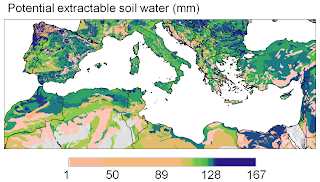Process-based soil water balance for olive
Olive is of major eco-social importance for the desertification-prone Mediterranean Basin, a climate change and biodiversity hotspot of global relevance where remarkable climate change is expected over the next few decades with unknown ecosystem impacts. However, climate impact assessments have long been constrained by a narrow methodological basis (ecological niche models, ENMs) that is correlative and hence largely omits key impact drivers such as trophic interactions and the effect of water availability. To bridge this gap, mechanistic approaches such as physiologically-based weather-driven demographic models (PBDMs) may be used as they embed by design both the biology of trophic interactions and a mechanistic representation of soil water balance. Here we report progress towards assessing climate effects on olive culture across the Mediterranean region using mechanistic PBDMs that project regionally the multitrophic population dynamics of olive and olive fly as affected by daily weather and soil water balance.
Ponti, L., Gutierrez, A.P., Basso, B., Neteler, M., Ruti, P.M., Dell’Aquila, A. and Iannetta, M., 2013. Olive agroecosystems in the Mediterranean Basin: multitrophic analysis of climate effects with process-based representation of soil water balance. Procedia Environmental Sciences, 19:122-131.
http://dx.doi.org/10.1016/j.proenv.2013.06.014 | Open access
Ponti, L., Gutierrez, A.P., Basso, B., Neteler, M., Ruti, P.M., Dell’Aquila, A. and Iannetta, M., 2013. Olive agroecosystems in the Mediterranean Basin: multitrophic analysis of climate effects with process-based representation of soil water balance. Procedia Environmental Sciences, 19:122-131.
http://dx.doi.org/10.1016/j.proenv.2013.06.014 | Open access


Comments
Post a Comment